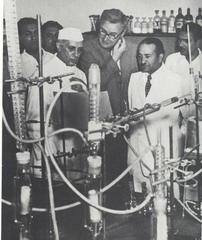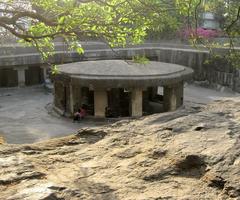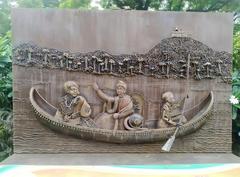Shaniwar Wada Pune: Comprehensive Visiting Hours, Tickets, and Historical Guide
Date: 14/06/2025
Introduction
Shaniwar Wada, located in the bustling heart of Pune, Maharashtra, is a monumental testament to the grandeur of the Maratha Empire and the city’s status as a historical and cultural epicenter. Built in 1732 under the commission of Peshwa Baji Rao I, this iconic fortification functioned as the official residence and administrative seat of the Peshwas—the prime ministers whose influence shaped 18th-century Indian history. The name “Shaniwar Wada” (“Saturday Palace”) commemorates the day its foundation was laid, embedding the site deeply in local tradition (eindiatourism.in; punethecity.com; Treebo).
Despite suffering devastating fires and the ravages of time, the surviving ramparts, gates, and landscaped gardens provide a compelling glimpse into the fort’s past splendor. Today, Shaniwar Wada stands as a living symbol of Pune’s rich Maratha heritage, captivating visitors with its architectural brilliance, historical tales, and cultural legacy.
Quick Reference: Visiting Details
- Location: Shaniwar Peth, Pune, Maharashtra 411030, India
- Visiting Hours: 9:00 AM–5:30 PM daily (last entry 5:00 PM)
- Entry Fees: ₹25 (Indian adults), ₹300 (foreign nationals), Free for children under 15
- Guided Tours: Available in Marathi, Hindi, and English
- Light & Sound Show: Marathi (7:15–8:10 PM), English (8:15–9:10 PM)
- Contact: +91 20 2612 6867
Table of Contents
- Origins and Construction
- Architectural Features
- Historical and Political Significance
- Restoration and Heritage Efforts
- Cultural Impact and Folklore
- Visiting Information: Hours, Tickets & Tips
- Best Time to Visit
- Attractions and Events
- Nearby Historical Sites
- FAQs
- Summary and Further Reading
Origins and Construction
Commissioned by Peshwa Baji Rao I in 1730 and completed in 1732, Shaniwar Wada was conceived as a grand seven-story palace. The foundation, marked on a Saturday, gave the fort its name. Initial plans called for an all-stone structure, but a royal decree from the Satara court restricted stone usage to only the emperor’s constructions, resulting in upper stories being built with brick and wood (Wikipedia). The blend of materials both showcased the architectural ambition of the Marathas and contributed to the fort’s eventual vulnerability to fire.
With an estimated construction cost of ₹16,110—a considerable sum in its era—the fort drew upon Maratha, Mughal, Rajasthani, and Gujarati influences, featuring robust stone walls, ornate wooden carvings, and intricate gardens (eindiatourism.in; punethecity.com; travelwithcrush.com).
Architectural Features
Gates and Entrances
Shaniwar Wada was originally fortified with five grand gates, each bearing unique architectural and historical significance:
- Delhi Darwaza: The imposing main entrance, facing north, signified Maratha ambitions toward Delhi. Its massive teak doors were reinforced with iron spikes to thwart elephant charges (Treebo).
- Mastani Darwaza: Named after Mastani, Bajirao’s consort, used by her and her entourage.
- Khidki Darwaza: Characterized by a small window for surveillance.
- Ganesh Darwaza: Used primarily by the women of the Peshwa household.
- Narayan Darwaza: The smallest gate, reportedly used for secret or emergency exits.
Palatial Complex and Gardens
Inside, the palace featured:
- Rang Mahal: Audience hall for royal court proceedings.
- Mastani Mahal: The private chamber of Mastani.
- Hazari Karanje: A remarkable lotus-shaped fountain with 1,000 water jets, a marvel of period engineering (incredibleindia.gov.in).
- Gardens: Lush charbagh-inspired gardens, lawns, and water features—best experienced during the monsoon and winter months.
Defensive Elements
The fort was designed for both grandeur and security, featuring:
- Thick stone walls and bastions with lotus-shaped carvings.
- Watchtowers and jharokhas for surveillance.
- Barbicans and defensive loopholes for artillery (Urban Precis).
Historical and Political Significance
Peshwa Era
Shaniwar Wada was the epicenter of Maratha administration under the Peshwas. The fort hosted critical political decisions, royal ceremonies, and military planning, solidifying Pune’s role as the de facto capital of the Maratha Empire (medium.com).
Tragic Events and Legends
Two events define the fort’s folklore:
- Assassination of Narayanrao Peshwa (1773): The young Peshwa was murdered within the fort, his ghostly pleas (“Kaka, mala vachva!”) said to still echo on full moon nights (eindiatourism.in).
- Great Fire of 1828: A catastrophic fire devastated most of the wooden superstructure, leaving only stone walls and select gateways intact.
Colonial Period and Decline
After the Maratha defeat in 1818, the British repurposed Shaniwar Wada for administrative use, further contributing to its decline (inmyi.com).
Restoration and Heritage Status
Following independence, the Government of Maharashtra and the Archaeological Survey of India undertook significant restoration efforts, stabilizing the ruins and enhancing public access. Shaniwar Wada is now a protected heritage monument, with ongoing conservation and landscaping projects (historicnation.in).
Cultural Impact and Folklore
Shaniwar Wada is not just a historical monument but a living part of Pune’s identity. It features prominently in local festivals, literature, and media—most notably in the film “Bajirao Mastani,” which rekindled public interest. The fort regularly hosts cultural events, including traditional dance and music performances, especially during Ganesh Chaturthi and Diwali (punethecity.com).
Visiting Shaniwar Wada: Hours, Tickets & Practical Tips
Visiting Hours
- Daily: 9:00 AM–5:30 PM (last entry at 5:00 PM)
- Light & Sound Show: Marathi (7:15–8:10 PM), English (8:15–9:10 PM) (punetourism.co.in)
Entry Fees
- Indian Adults: ₹25
- Foreign Nationals: ₹300
- Children under 15: Free
- Light & Sound Show: Adults ₹25, Children below 12 ₹15, Foreigners ₹300 (tripoto.com)
Tickets
Tickets can be purchased at the entrance or online via official tourism websites (heypune.in).
Accessibility & Facilities
- Getting There: Centrally located, accessible by taxi, auto-rickshaw, bus. Pune Railway Station is ~3 km away.
- Parking: Limited parking available; arrive early, especially on weekends (heypune.in).
- Restrooms: Near the entrance.
- Food: Local street food stalls nearby (urtravelguide.com).
- Accessibility: Uneven surfaces and steps; limited facilities for disabled visitors; rest areas in gardens.
Guided Tours
Local guides offer tours in Marathi, Hindi, and English, providing insights into the fort’s history and legends (mumbai7.com).
Best Time to Visit
- Winter (Nov–Feb): Pleasant weather, ideal for exploration (travelsetu.com).
- Monsoon (Jun–Sep): Gardens are lush, fountains active, but surfaces may be slippery.
- Summer (Mar–May): Hot and humid; visit in morning or late afternoon.
Weekdays and early hours are less crowded; avoid weekends and festivals for a quieter experience (tripoto.com).
Attractions and Activities
- Explore the Five Gates: Each with unique stories and architecture.
- Fort Walls and Bastions: Climb for panoramic city views.
- Nagarkhana (Drum House): Admire the latticework and wood pillars.
- Gardens and Fountains: Best during monsoon and winter.
- Paintings and Murals: Depict scenes from Hindu epics (punetourism.co.in).
- Light & Sound Show: A dramatic retelling of the fort’s history.
- Photography: Mobile phones allowed; professional equipment not permitted inside (heypune.in).
Nearby Historical Sites
- Aga Khan Palace
- Raja Dinkar Kelkar Museum
- Parvati Hill
- Dagdusheth Halwai Ganpati Temple (wakaabuja.com)
- Lal Mahal (guidetour.in)
- Pataleshwar Cave Temple
Frequently Asked Questions (FAQ)
Q: What are the Shaniwar Wada visiting hours?
A: 9:00 AM–5:30 PM daily (last entry at 5:00 PM).
Q: How much are tickets?
A: ₹25 for Indian adults, ₹300 for foreign nationals, free for children under 15.
Q: Are guided tours available?
A: Yes, in Marathi, Hindi, and English at the entrance.
Q: Is photography allowed?
A: Yes, with mobile phones; professional cameras not permitted.
Q: Is the fort accessible for people with disabilities?
A: Accessibility is limited; assistance may be required.
Visitor Tips
- Wear comfortable shoes; surfaces can be uneven.
- Carry water and sun protection.
- Arrive early to avoid crowds.
- Respect the monument; avoid littering or defacing (mumbai7.com).
- Modest attire is recommended, especially during festivals (hindustantimes.com).
Summary
Shaniwar Wada is more than a historic relic—it is a living symbol of Pune’s identity, a beacon of Maratha pride, and a witness to centuries of political drama, artistry, and folklore. Restoration and conservation efforts ensure that the fort remains accessible, while guided tours and cultural events bring its stories to life. Whether you are a history enthusiast or a casual traveler, a visit to Shaniwar Wada promises an immersive journey into Pune’s illustrious past (travelwithcrush.com; punetourism.co.in; eindiatourism.in).
Sources and Further Reading
- Shaniwar Wada Exploring Pune’s Famous Historic Landmark, eindiatourism.in
- Shaniwar Wada: This historical fortification is an iconic symbol of Pune, punethecity.com
- Shaniwar Wada Visiting Hours, Tickets & Architectural Guide to Pune’s Historic Fort, Treebo
- The Insider’s Guide to Shaniwar Wada, Treks and Trails
- Shaniwar Wada – The Palace of the Peshwa, Medium
- Shaniwar Wada History & Heritage Walk, inmyi.com
- Modern Vernacular Fusion: A Case of Wada Architecture in Pune, Urban Precis
- Shaniwar Wada Fort Pune – Interesting Facts, Information & Travel Guide, HollyMelody
- Shaniwar Wada Pune: Visiting Hours, Tickets, History & Travel Guide, heypune.in
- Shaniwar Wada Tourism Guide, travelwithcrush.com
- Shaniwar Wada Pune – Official Tourism Site, punetourism.co.in




